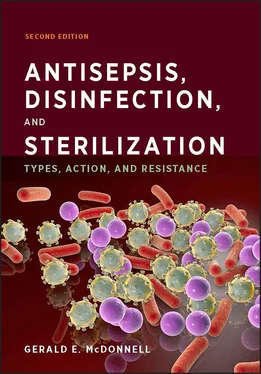The current understanding of the mechanisms of biocidal action on microorganisms is considered. In most cases, the modes of action of biocides are quite distinct from the more specific mechanisms of action described for anti-infective agents such as antibiotics and antiviral agents. Most biocides demonstrate a wider range of antimicrobial activity, generally corresponding to nonspecific and varied modes of action. The mechanisms of action of biocides are considered in four general categories: oxidizing agents, cross-linking agents, agents that act by transfer of energy, and other structure-disrupting agents. Despite these general mechanisms, some biocides have been shown to have primary targets similar to those of certain antibiotics, and a better understanding of their mechanisms of action is of interest in the development of the next generation of anti-infectives.
Microorganisms demonstrate various natural (intrinsic) and acquired mechanisms to resist the biocidal effects of chemical and physical processes. These mechanisms are also discussed and are important to consider in order to ensure the safe and effective use of biocides and biocidal processes. This topic has been particularly highlighted with the development of resistance to widely used anti-infectives (notably antibiotic-resistant bacteria), but similar mechanisms in microbial resistance to biocides and biocidal processes have been described. Biocide resistance in bacteria has been studied in some detail, with many examples of intrinsic and acquired mechanisms of resistance. Intrinsic mechanisms include biofilm formation and the development of dormant endospores. Acquired resistance mechanisms due to mutations and the acquisition of plasmids, not unlike those described for antibiotics, have also been described. Although many of these mechanisms allow for tolerance in the presence of biocides only at normally inhibitory levels, other mechanisms have been shown to dramatically change the response of a microorganism to biocides and to enable it to survive highly toxic conditions. Although less studied, specific mechanisms of resistance in viruses, prions, and fungi and other eukaryotes are also described.
Overall, it is intended that this book will give a basic understanding of and reference for the various types, modes of action, and mechanisms of resistance of antiseptics, disinfectants, and sterilants for students of microbiology, chemistry, infection control, contamination control, public health, and manufacturing. A greater understanding and appreciation of these technologies will ensure their long-term safe and effective use in contamination and infection prevention.
I greatly appreciate the many colleagues and friends who reviewed selected chapters of this book, as well as my wife, Lesley, for her encouragement.
GERALD E. MCDONNELL
Basingstoke, Hampshire, United Kingdom
Gerald E. McDonnell received a B.Sc. degree in medical laboratory sciences from the University of Ulster (1989) and a Ph.D. in microbial genetics at the Department of Genetics, Trinity College, University of Dublin (1992). His graduate work involved studies on the control of gene expression in Bacillus subtilis . He spent 3 years at the Mycobacterial Research Laboratories, Colorado State University, investigating the mechanisms of antibiotic resistance and cell wall biosynthesis in mycobacteria. In 1995 he joined the St. Louis, Mo., operations of ConvaTec, a division of Bristol-Myers Squibb, as a group leader in microbiology in the research and development of skin care, hard surface disinfection, and cleaning chemistries. He then joined STERIS Corporation and has worked for STERIS for more than 10 years in the United States and in the company’s European, Middle East, and Africa (EMEA) region on the development, research, and support of infection and contamination prevention products and services, including cleaning, antisepsis, disinfection, and sterilization. Dr. McDonnell is currently the vice president of research and EMEA affairs for STERIS, based at its facility in Basingstoke, United Kingdom. He is responsible for the development and support of decontamination processes and services, and he provides training on various aspects of decontamination and contamination control. His basic research interests include infection prevention, decontamination microbiology, emerging pathogens, and modes of action and resistance to biocides. His work also includes the development and implementation of international and national guidance and standards in decontamination. He has published widely in peer-reviewed journals and books, has been granted patents in decontamination technologies, and frequently gives presentations on various aspects of his work at scientific meetings around the world.
The author has taken great care to confirm the accuracy of the information presented in this book, based on peer-reviewed publications at the time of preparation. However, the author and publisher make no warranty, expressed or implied, that the information in this book is accurate or appropriate for any particular facility, environment, or individual situation, and they are not responsible for any consequences of application of any of the information in this book by any reader. The inclusion of specific products, instruments, reagents, or methods does not represent any endorsement by the American Society for Microbiology, ASM Press, or the author. Nor does the inclusion or inadvertent exclusion of any product, instrument, reagent, or method reflect a preference for any product over other similar competitive products. The comments included in this book are strictly those of the author and do not necessarily reflect the views of his employer. Some of the products, tests, methods, and applications discussed in this book have particular U.S. Food and Drug Administration (FDA) and Environmental Protection Agency (EPA) approval for selective uses; further specific approvals or exclusions may also apply to other international regulatory agencies within specific geographic areas or countries. It is the responsibility of the reader to ensure the necessary local approval status of any product or process that is considered for use in his or her particular hospital, industrial, environmental, or private setting or practice.
1
INTRODUCTION
1.1 GENERAL INTRODUCTION
Microbiology is the study of microscopic organisms (microorganisms). Microorganisms play important roles in our lives, for our benefit as well as to our detriment. Of primary interest are those microorganisms that cause diseases under a variety of circumstances. Other issues include the economic aspects associated with microbial contamination, such as food spoilage, plant infections, and surface damage. The control of microorganisms is therefore an important concern in preventing contamination, as well as removing or reducing it when it occurs. A variety of physical and chemical methods are used for these purposes in antisepsis, disinfection, and sterilization applications. Disinfection and sterilization are used for the control of microorganisms on surfaces, in liquids, or in areas, while antisepsis is particularly associated with microbial reduction on the skin or mucous membranes. These biocidal applications are varied and include skin washing, wound treatment, product preservation, food and water disinfection, surgical-device decontamination, and product sterilization. Many of these processes have been used historically and are described in many ancient texts and writings. Despite this, it is only in the last 150 years, as our knowledge and understanding of microbiology has expanded, that the impact of antiseptics, disinfectants, and sterilants has been truly appreciated. Their utilization has played and continues to play an important role in significantly reducing the incidence of infectious diseases, such as gastroenteritis and pneumonia. Today, microorganisms are still a significant cause of morbidity, mortality, and economic loss, and we continue to be challenged with the identification of “newer” microorganisms, like Legionella , antibiotic-resistant bacteria, human immunodeficiency virus (HIV), Ebola virus, viroids, and prions.
Читать дальше












